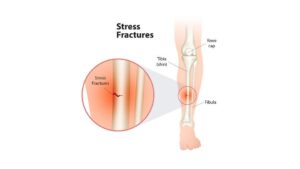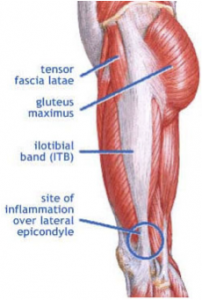Running is one of the most popular exercises that people use to stay fit. It’s a relatively low-impact option compared to some of the other physical activities that you can choose from, but injuries can still occur. Studies have found that lower extremity running injuries can range in prevalence from about 19.4% up to as much as 79.3%, depending on the specific study group and population.
Common running injuries can quickly put you on the rest bench, which can be

detrimental for professionals and if you depend on this activity to keep yourself fit. Some injuries are more common than others, which is what we will focus on in this article. We’ll consider how running affects you and also look at what you can do to prevent these injuries.
What Are The Most Common Running Injuries?
When you go for a run, it’s not uncommon to feel some aches and pains. They are generally normal, especially if you are just getting started. Your muscles are worked while you run, and then need to go through a recovery phase.
With this said, it’s important to understand when those aches are more serious. When you have an injury, then you have to take the appropriate measures to avoid a worsening of the symptoms. We are going to take a closer look at some common running injuries that affect the average individual, as well as athletes. We’ll discuss the symptoms, how they happen, and what to expect. This will help you look out for symptoms that signal a need to take things slow for a bit.
1. Stress Fractures
Stress fractures are quite common among runners and can affect different areas of your  body. This includes your hip, foot, pelvis, thigh, or your shin. It is important to understand that stress fractures do require appropriate treatment as they are considered more serious than some other running injuries.
body. This includes your hip, foot, pelvis, thigh, or your shin. It is important to understand that stress fractures do require appropriate treatment as they are considered more serious than some other running injuries.
Consistent pain is the most common symptom you’ll notice with a stress fracture. In athletes and runners, stress fractures are most commonly caused by the impact of force on a normal bone.
There are usually multiple phases used in the recovery of the stress fracture. Treatment will largely depend on the severity of the fracture, as well as the location. You’ll first need to undergo an MRI or bone scan to help the healthcare professional accurately diagnose the injury. More information on stress fractures.
2. Runner’s Knee
Another common running injury is a runner’s knee. It’s actually a type of umbrella term that refers to an injury that causes pain around the patella of your knee. The patella is also known as the kneecap. Running tend to put continued stress on your knee joint, which is usually the main cause of this injury.
Women are more likely to develop a runner’s knee,, but the problem can also affect men. If you have a runner’s knee, you may experience pain in the area when you walk, use stairs, squat, and when running. It’s best to get a comprehensive physical examination to diagnose a runner’s knee. Your doctor may also order imaging tests, such as a CT scan or X-rays, to help them in the diagnosis. More information on runner’s knee.
3. Achilles Tendonitis
The Achilles tendon is responsible for creating a connection between the heel bone and the calf muscles. When they become overworked, they can develop an injury commonly known as Achilles tendonitis.
It’s more common for Achilles tendonitis to develop if you push yourself too much. For example, you might try to significantly increase the intensity of your running activities without making the changes gradually.
When you have Achilles tendonitis, rest and recovery is important. This can help to reduce the risk of recurrence. If your Achilles tendon ruptures, however, then there is a chance you may need to undergo a surgical procedure. More information on achilles tendonitis.
4. Hamstring Injuries
Your hamstrings are worked while you run, and they sit at the back of your thigh. If you overwork these muscles, it’s possible to sprain them. It’s also possible for a tear to develop in the hamstrings. Apart from overworking the muscles, suddenly stopping while you are going at high speed can also increase the risk of hamstring injuries.
It’s also possible to develop hamstring injuries when you continuously run on the same surface. It’s a good idea to add some variation to the surfaces you run on when it comes to avoiding hamstring injuries. More information on hamstring strains.
5. Shin Splints
With a shin splint, pain develops in the area where the tibia is located. It’s also known as your shin bone and sits at the front area of your lower legs. This is actually a relatively common occurrence among runners.
Similar to Achilles tendonitis, suddenly making changes to the intensity or training routine you use as a runner greatly increases the risk of shin splints. Fortunately, in most cases, self-care strategies are enough to take care of the injury, with rest being particularly important. More information on shin splints.
6. Plantar Fasciitis
Plantar fasciitis is among the common running injuries that affect your lower body. This  injury particularly relates to your feet and tends to cause heel pain and inflammation in the surrounding area. In this particular case, you injure your plantar fascia, which is a fibrous tissue that starts at the heel and ends at the ball of your feet while also extending toward your toes.
injury particularly relates to your feet and tends to cause heel pain and inflammation in the surrounding area. In this particular case, you injure your plantar fascia, which is a fibrous tissue that starts at the heel and ends at the ball of your feet while also extending toward your toes.
This particular tissue is responsible for connecting different bones in your feet together. It is also the tissue that forms the arch that can be seen when you look at the bottom of your feet. If you stretch the plantar fascia too much or you overwork it, then plantar fasciitis can develop. More information on plantar fasciitis.
7. Iliotibial Band Syndrome
There are connective tissues that run from the hips down to the knee and your shinbone.  It is called the iliotibial band, and sometimes, injury affects this tissue. Iliotibial band syndrome refers to the tightening of this particular tissue, which then causes a rubbing action against your thighbone.
It is called the iliotibial band, and sometimes, injury affects this tissue. Iliotibial band syndrome refers to the tightening of this particular tissue, which then causes a rubbing action against your thighbone.
In most cases, Iliotibial band syndrome causes pain symptoms to develop either on the outer side of your hip or knee. This is due to swelling that occurs in the iliotibial band, which can create irritation and pain as well. More information on iliotibial band syndrome.
What Can You Do To Prevent Running Injuries?
We’ve taken a closer look at some common running injuries. Hip, knee, ankle, and foot pain can develop when you have one of these injuries. While there are management strategies and even medical interventions available, it’s generally a better idea to take the necessary precautions to avoid injuries in the first place.
By preventing running injuries, you give yourself an opportunity to continue enjoying this fitness activity without having to be concerned about pain, damage in your body, and time off the field.
Let’s observe a couple of useful tips that can help to prevent some of the most common running injuries.
- Pre-Workout Stretches: We’ve all heard that stretching before exercise is really important, but how many times do you take off without spending some time doing these stretches? Stretches prior to a workout can greatly help to improve the elasticity of your muscle tissues and even reduce your risk of injuries. When you do not stretch beforehand, your muscles are not warmed up, and they are stiff.
- Injury Prevention As A Priority: Planning out your running exercise beforehand is another important tip. Develop a program that gradually increases the intensity of your running activities. This helps you get into the habit of planning with injury prevention as a priority. If you’re new to running or fitness activities, start with just a few minutes each day at a low intensity, then work your way up.
- Strengthen Your Lower Body: Running can be a great way to target different parts of your body, but most of the impact falls on your lower body. Take some time to perform strengthening exercises that can help to provide greater support to joints and ligaments located in your legs, feet, and pelvis area.
There are other strategies that you can use to reduce your risk of injury too. One important thing to consider is to work on your flexibility while still building strength. Foam rollers, for example, are a type of massage tool that does not require a visit to a specific facility. They are easy and simple to use.
In one study, researchers considered the impact that foam rollers have on flexibility as well as strength. The effects of the foam roller were compared to dynamic and static stretching exercises. After comparing the results of all three activities, they concluded that foam rolling held the most promising results. Knee extension peak torque also had a significant improvement with foam rolling in this study.
How to prevent knee injuries when running?
Preventing injuries does not only include strategies that you can use prior to or after your running session. When it comes to preventing common running injuries, you should focus on what you do during the exercise too.
It’s important to wear the correct shoes. A study compared the use of neutral shoes to footwear that has motion control capabilities and found that they can provide a reduction in the risk of certain running injuries.
Apart from the correct footwear, listen to your body. If you feel like the session is putting too much strain on you, stop before you push yourself too far. By going over your limit, you increase your risk of serious injuries and complications. Instead of suddenly increasing your speed or the duration of the run, rather work up your stamina, fitness, and strength gradually.
You should also try to avoid stopping suddenly while you run, especially if you are going at a relatively fast speed. This can heighten the risk of certain injuries, such as tearing your hamstring ligaments.
Conclusion
Even though running can be a fun exercise, it’s important to consider the risk of plantar fasciitis, runner’s knee, Achilles tendonitis, and other potential injuries that can develop. With the right preventative strategies in place, you can effectively reduce your risk of these common running injuries. If you do become a victim of an injury, be sure to rest up and take the necessary steps to promote recovery before you head back to the track.
How to recover from (and/or prevent) common running injuries. https://t.co/wTs5LMmCwa pic.twitter.com/G6kcEUogYC
— Runner’s World (@runnersworld) August 4, 2018
References
https://pubmed.ncbi.nlm.nih.gov/17473005/
https://www.active.com/running/articles/5-phases-of-stress-fracture-recovery
https://www.health.harvard.edu/blog/taking-the-pain-out-of-runners-knee-201106072801
https://my.clevelandclinic.org/health/diseases/14709-plantar-fasciitis
https://pubmed.ncbi.nlm.nih.gov/27736289/
https://pubmed.ncbi.nlm.nih.gov/33306927/
